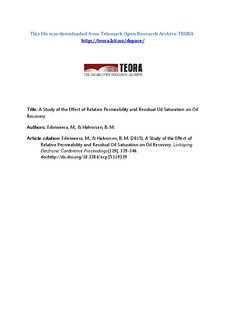A Study of the Effect of Relative Permeability and Residual Oil Saturation on Oil Recovery
Journal article, Peer reviewed
Published version
Permanent lenke
http://hdl.handle.net/11250/2438594Utgivelsesdato
2015-11-25Metadata
Vis full innførselSamlinger
Originalversjon
Ediriweera, M., & Halvorsen, B. M. (2015). A Study of the Effect of Relative Permeability and Residual Oil Saturation on Oil Recovery. Paper presented at the 56th Conference on Simulation and Modelling (SIMS 56), October, 7-9, 2015, Linköping University, Sweden. http://doi.org/10.3384/ecp15119339Sammendrag
The depletion of oil production and the low recovery rate are the major challenges faced in oil production. Several studies have shown that considerable amount of oil still remains in the reservoir after the well shutdown. Heavy oil reservoirs occupy more than two third of globally oil reserves. The recovery factor and the lifetime of a well in heavy oil reservoirs is strongly affected by reservoir properties as permeability and porosity, residual oil saturation and the time of water breakthrough. Different enhanced oil recovery (EOR) methods are used to change the relative permeability and the residual oil saturation. In this study, modelling and simulations are carried out to observe the influence of the relative permeability on oil recovery. The relative permeability in a reservoir changes with time due to the change in water saturation during oil production. Simulations are performed on reservoirs with an underlying aquifer using different relative permeability curves and various residual oil saturations. The study has mainly focused on the impact on the total flow rates, the water breakthrough time and the oil recovery. The reservoir simulator, Rocx in combination with OLGA is used in this research work. The results show that the total oil production and the time of water breakthrough are strongly affected by the relative permeability. These outcomes can be utilized when considering EOR methods to increase the oil recovery factor and delaying water breakthrough in future.
